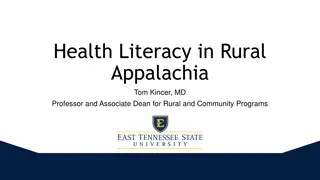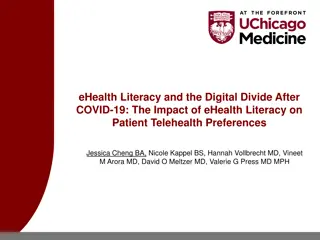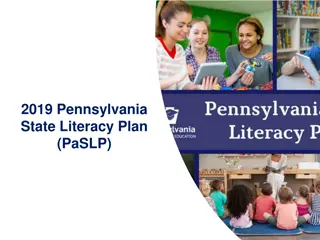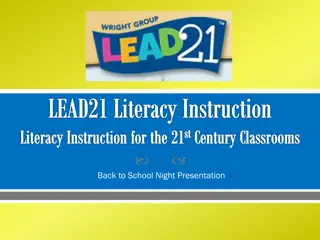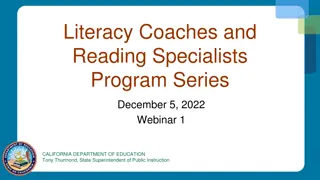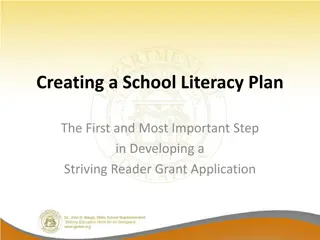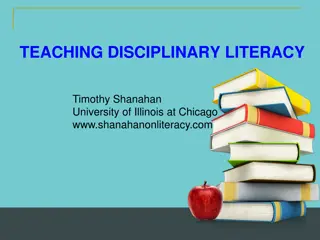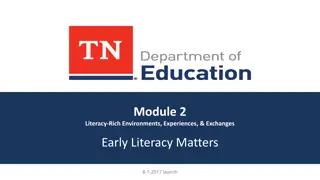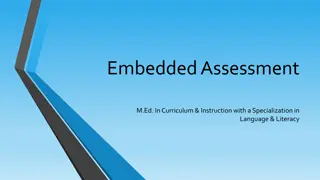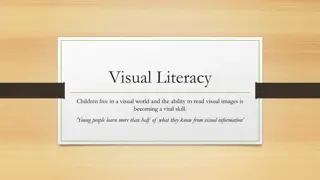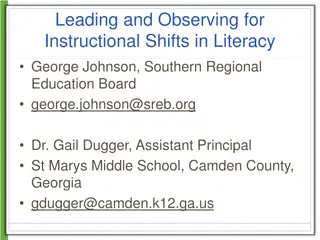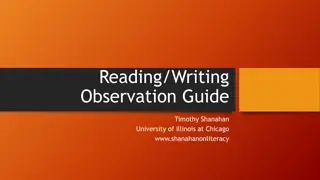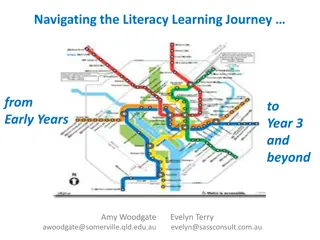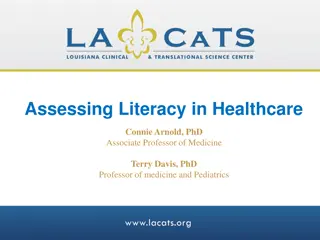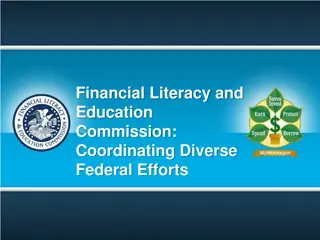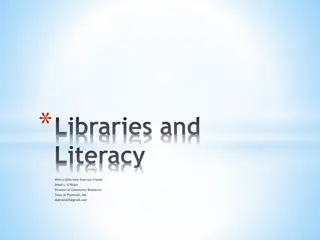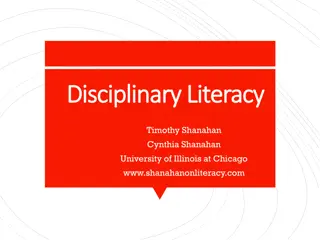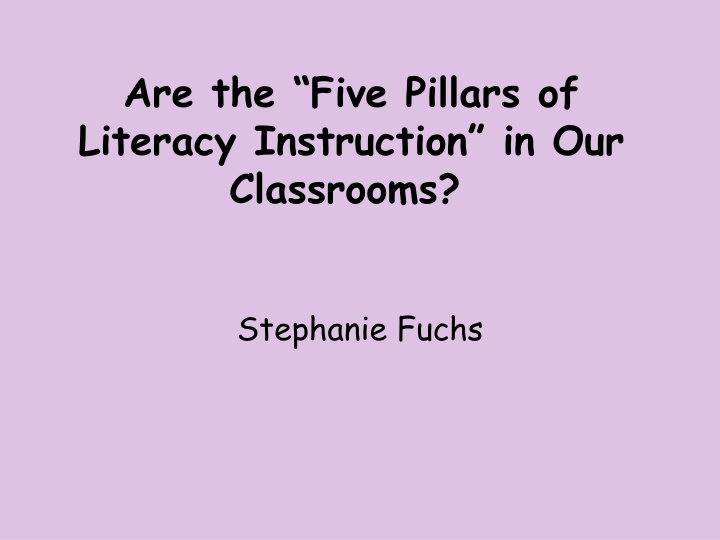
Understanding the Five Pillars of Literacy Instruction
Explore the essential components of literacy instruction, known as the Five Pillars: phonemic awareness, phonics, reading fluency, vocabulary, and reading comprehension. Learn about the significance of each pillar in enhancing English language literacy skills.
Download Presentation

Please find below an Image/Link to download the presentation.
The content on the website is provided AS IS for your information and personal use only. It may not be sold, licensed, or shared on other websites without obtaining consent from the author. If you encounter any issues during the download, it is possible that the publisher has removed the file from their server.
You are allowed to download the files provided on this website for personal or commercial use, subject to the condition that they are used lawfully. All files are the property of their respective owners.
The content on the website is provided AS IS for your information and personal use only. It may not be sold, licensed, or shared on other websites without obtaining consent from the author.
E N D
Presentation Transcript
Are the Five Pillars of Literacy Instruction in Our Classrooms? Stephanie Fuchs
The Five Pillars The Five Pillars of literacy, identified by the National Reading Panel (2000) are: phonemic awareness, phonics, reading fluency, vocabulary and reading comprehension. These are considered crucial components in any literacy instruction program for English as a first language (L1).
Phonemic Awareness Phonemic Awareness is the ability to focus on phonemes in spoken words and manipulate them in language activities (Adams, 1990; Cassidy et al., 2010). identifying sounds at the beginning or end of words practicing oral rhyming counting the number of sounds in words deleting or switching one sound in a word
Phonics Phonics is the correspondence between graphemes and phonemes which must be taught systematically and explicitly (Adams, 1990; Moats, 2000; Rayner, 2001). Teaching the letters and their sounds Teaching the orthographic patterns (letter combinations) and their sounds Teaching spelling rules Providing phonic texts for reading practice (texts that can be read by sounding out each letter or letter combination that have already been taught, with no or very few irregular words)
Reading Fluency Reading Fluency is one of the strongest predictors of overall reading ability (Rasinski, Homan, & Biggs, 2009; Rasinski, 2012) and is defined as the ability to read text quickly, effortlessly, and with good, meaningful expression (Begeny et al., 2012; Grabe, 2009; Meisinger et al., 2010; National Reading Panel, 2000). Silent repeated reading Reading aloud to a partner or small group Listening to the teacher reading while following the text to expose the pupils to correct punctuation and intonation
Vocabulary Vocabulary knowledge promotes the ability of students to derive meaning from text (Brusnighan & Folk, 2012; Hawkins, Hale, Sheely, & Ling, 2011) and knowledge of the words in a text has been shown to highly affect reading performance (Moats, 2000; Schmitt, Jiang, & Grabe, 2011). Teaching single words or chunks of language (a) connected to the topic of the currently taught unit (b) frequently used that are not directly connected to the topic in the unit (only, just, but, etc.) (c) phonically connected
Reading Comprehension Reading comprehension requires students to read and extract meaning by interacting with the text (Grabe, 2009; Solis, Ciullo, Vaughn, Pyle, Hassaram, & Leroux, 2012). identifying the main idea of a text independent reading of simple texts silently and demonstrating understanding by answering questions orally or in writing comparing what pupils have read to their own personal experiences or to other things that they have read making predictions about what will happen next in a text identifying and describing types of texts
EFL Literacy Instruction English as a Foreign Language (EFL) literacy instruction depends on multiple skills which are in many ways similar to those incorporated in L1 instruction (Lipka & Siegel, 2012), including the Five Pillars of literacy. As in L1 instruction, providing a strong foundation of the language skills in the early stages of instruction is essential for EFL as well, with an emphasis on reading and writing which are intertwined from these initial stages (Olshtain, 2014).
The Five Pillars in EFL EFL literacy instruction should be based on the Five Pillars. Since reading requires both bottom-up and top-down skills that must be integrated, the critical lower-order skills must be taught in parallel to meaning and comprehension, the higher-order thinking skills, from the beginning of EFL instruction and throughout the school years (Ediger, 2014; Grabe, 2009; Wolf & Katzir-Cohen, 2001).
EFL Specific Literacy Instruction Components It is important to remember that there are EFL specific literacy topics including grammar, speaking, listening, writing and spelling which also need to be incorporated in our literacy programs. These must be taken into consideration when examining a textbook.
Do the Textbooks Provide Five Pillars Activities? Let s look at an example in a widely used textbook: Click 1, Unit 3, Animals Examining Textbook CLICK 1 for Literacy Instruction Components.docx
Percentages of Coverage The percentages of coverage for the Five Pillars in this unit are: Phonemic Awareness -8.77% Phonics 19.29% Reading Fluency 0% Vocabulary 10.52% Reading Comprehension 8.77%
What Do We Need to Add? For which of the Five Pillars do we need to add activities in our literacy instruction, in your opinion? Can you suggest additional activities for these pillars? Here s an idea for a reading fluency lesson: The_Fluency_Development_Lesson_Rasi nski_2009.doc
Activities: Examining the Textbooks In pairs: Choose one of the textbooks commonly used in elementary schools. Choose one unit to examine. Fill in the given table to find out what percentage of activities in this unit is devoted to practicing each of the five pillars. Share your findings with the other participants.
References Adams, M. J. (1990). Beginning to read: Thinking and learning about print. Cambridge, MA: MIT. Begeny, J. C., Ross, S. G.; Greene, D. J., Mitchell, R. C. & Whitehouse, M. H. (2012). Effects of the helping early literacy with practice strategies (HELPS) reading fluency program with Latino English language learners: A preliminary evaluation. Journal of Behavioral Education, 21(2), 134-149. doi:10.1007/s10864-011-9144-7 Brusnighan, S.M.& Folk, J.R. (2012). Combining contextual and morphemic cues is beneficial during incidental vocabulary acquisition: Semantic transparency in novel compound word processing. Reading Research Quarterly, 47(2), 172-190. doi: 10.1002/RRQ.015 Cassidy, J.,Valadez, C.M., Garrett, S.D. (2010). Literacy trends and issues: A look at the five pillars and the cement that supports them. The Reading Teacher, 63(8), 644 655. DOI:10.1598/RT.63.8.3 Ediger, A.M. (2014). Teaching second/foreign language literacy to school-age learners. In Celce-Murcia, Brinton, D.M., & Snow, M.A. (eds.) Teaching English as a second or foreign language. Fourth edition. Boston: National Geographic Learning. (pp. 154-188). Grabe, W. (2009a). How reading works: The building blocks of fluency and comprehension. In Reading in a second language: Moving from theory to practice. (pp. 21-38). New York: Cambridge University Press. Hawkins, R.O., Hale, A. Sheely, W., Ling, S. (2011). Repeated reading and vocabulary-previewing interventions to improve fluency and comprehension for struggling high-school readers. Psychology in Schools, 48(1), 50-77. doi:10.1002/pits.20545 Lipka, O. & Siegel, L. (2012). The development of reading comprehension skills in children learning English as a second language. Reading and Writing, 25, 1873-1898. doi: 10.1007/s11145-011-9309-8 Meisinger, E.B., Bloom, J.S. & Hynd, G.W. (2010). Reading fluency: implications for the assessment of children with reading disabilities. Annals of Dyslexia, 60, 1 17. Moats, L.C. (2000). Speech to print: language essentials for teachers. Baltimore: Brookes. Olshtain, E. (2014). Practical tasks for mastering the mechanics of writing and going just beyond. In Celce-Murcia, Brinton, D.M., & Snow, M.A. (eds.) Teaching English as a second or foreign language. Fourth edition. Boston: National Geographic Learning. (pp. 208-221). Rasinski, T., Homan, S., & Biggs, M. (2009). Teaching reading fluency to struggling readers: Method, materials, and evidence. Reading & Writing Quarterly, 25(2-3), 192-204. Rasinski, T. V. (2012). Why reading fluency should be hot. The Reading Teacher, 65(8), 516-522. doi: 10.1002/TRTR.01077 Rayner, K., Foorman, B. R., Perfetti, C. A., & Pesetsky, D. & Seidenberg, M.S. (2001). How psychological science informs the teaching of reading. Psychological Science in the Public Interest, 2(2), 31-74. Schmitt, N., Jiang, X., & Grabe, W. (2011). The percentage of words known in a text and reading comprehension. The Modern Language Journal, 95(1), 26-43. Solis, M., Ciullo, S., Vaughn, S., Pyle, N., Hassaram, B., & Leroux, A. (2012). Reading comprehension interventions for middle school students with learning disabilities: A synthesis of 30 years of research. Journal of Learning Disabilities, 45(4), 327-340. doi: 10.1177/0022219411402691 Wolf, M. & Katzir-Cohen, T. (2001). Reading fluency and its intervention. Scientific Studies of Reading, 5, 211-239.


